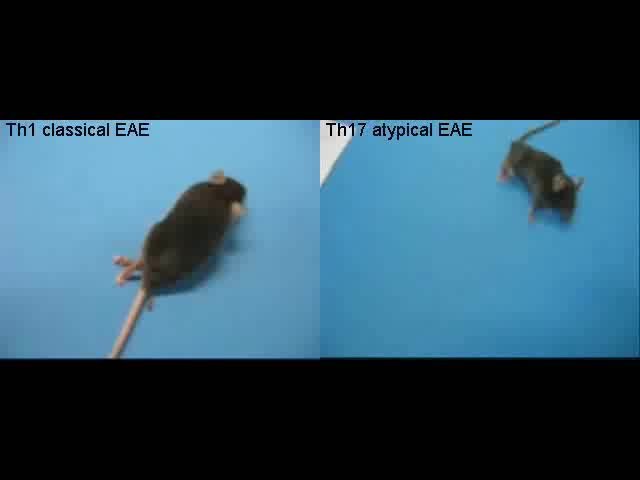Atypical models of experimental autoimmune encephalomyelitis (EAE) are advantageous in that the heterogeneity of clinical signs appears more reflective of those in multiple sclerosis (MS). Conversely, models of classical EAE feature stereotypic progression of an ascending flaccid paralysis that is not a characteristic of MS. The study of atypical EAE however has been limited due to the relative lack of suitable models that feature reliable disease incidence and severity, excepting mice deficient in gamma-interferon signaling pathways. In this study, atypical EAE was induced in Lewis rats, and a related approach was effective for induction of an unusual neurologic syndrome in a cynomolgus macaque. Lewis rats were immunized with the rat immunoglobulin variable (IgV)-related extracellular domain of myelin oligodendrocyte glycoprotein (IgV-MOG) in complete Freund's adjuvant (CFA) followed by one or more injections of rat IgV-MOG in incomplete Freund's adjuvant (IFA). The resulting disease was marked by torticollis (twisted neck), unilateral rigid paralysis (limb stiffness on one side), forelimb weakness, and high titers of anti-MOG antibody against conformational epitopes of MOG, as well as other signs of atypical EAE. A similar strategy elicited a distinct atypical form of EAE in a cynomolgus macaque. By day 36 in the monkey, titers of IgG against conformational epitopes of extracellular MOG were evident, and on day 201, the macaque had an abrupt onset of an unusual form of EAE that included a pronounced arousal-dependent, transient myotonia. The disease persisted for 6-7 weeks and was marked by a gradual, consistent improvement and an eventual full recovery without recurrence. These data indicate that one or more boosters of IgV-MOG in IFA represent a key variable for induction of atypical or unusual forms of EAE in rat and Macaca species. These studies also reveal a close correlation between humoral immunity against conformational epitopes of MOG, extended confluent demyelinating plaques in spinal cord and brainstem, and atypical disease induction.
Myelin oligodendrocyte glycoprotein injected in animals in adjuvants can induce disease. In this study they report that Lewis rats get different signs when sensitized to the external part of myelin oligodendrocyte glycoprotein (MOG) and get a twisted neck, one-sided stiffness and front leg weakness. If you continue to inject you get lots of MOG-reactive antibodies. However, in some strains of rodents and non human proimates this approach can also induce typical paralysis that starts with the tail and then moves to the high limbs. This study argues that models showing different signs of disease are more like MS because they show different signs. These "atypical" signs are often associated with a different lesion profile and the twisted neck or rotation of animals is not an usual feature of EAE, it is simply not reported. In other studies atpical signs may be associated with the type of T cell (Th1 vs Th17) response elicited.
However, the problem is that when disease is so inconsistent it is difficult to score and use for disease manipulation studies and the model has limited use because it may mean that more rather than less animals are used.
Will it catch on?
However, the problem is that when disease is so inconsistent it is difficult to score and use for disease manipulation studies and the model has limited use because it may mean that more rather than less animals are used.
Will it catch on?
